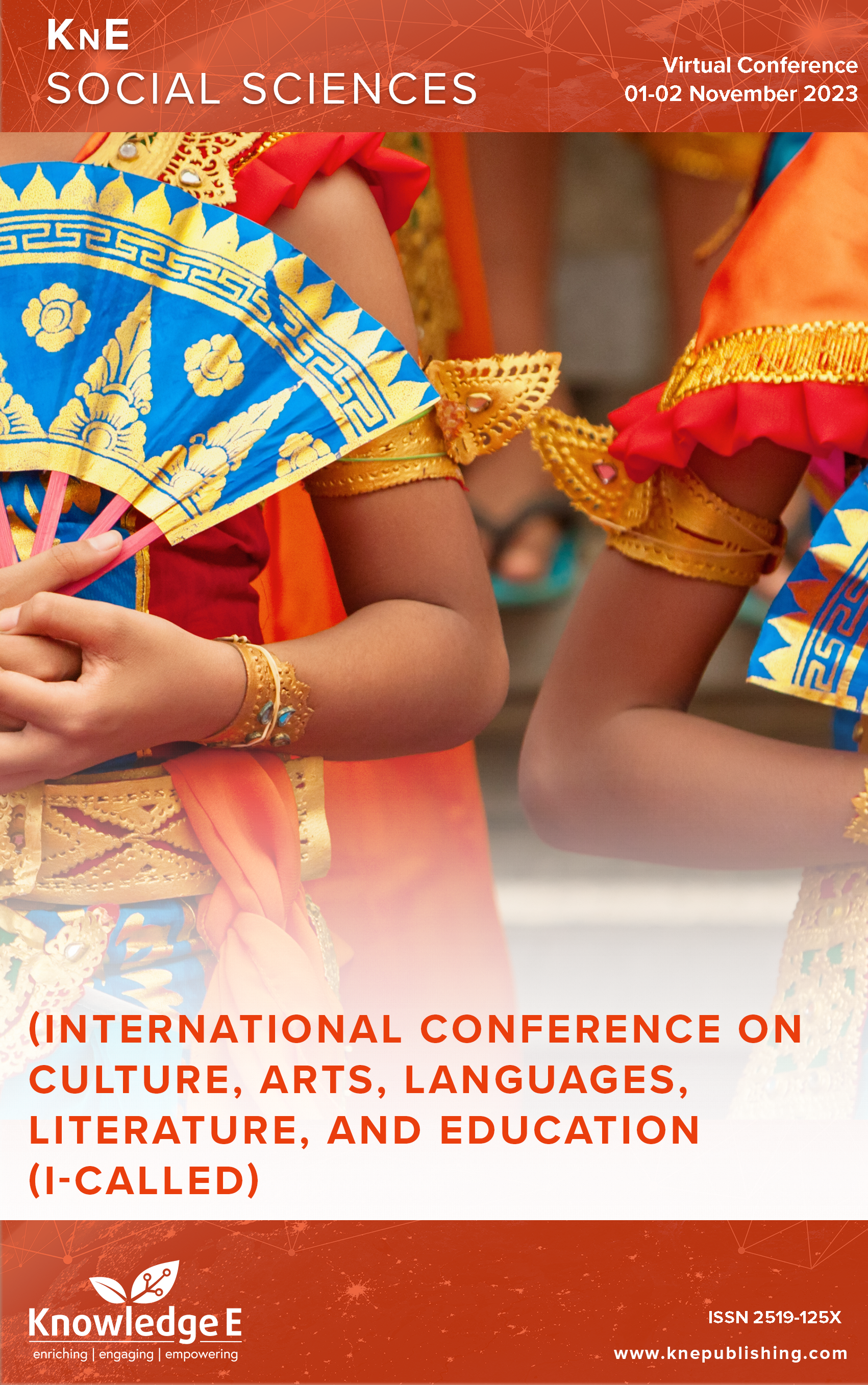Microlearning-based Tourism Arabic Teaching Material Model for Tourism Awareness Groups in Tourism Villages
DOI:
https://doi.org/10.18502/kss.v9i9.15659Abstract
The present imperative for members of the tourism awareness group (Pokdarwis) in the tourist village is to acquire proficiency in Arabic communication skills. This study aims to provide instructional materials for teaching Arabic language skills to members of the tourism village Pokdarwis, with a specific focus on the field of tourism. To achieve this, a micro-learning technique was employed. The study primarily addressed the constraints of the problem, which pertained to the absence of tourist Arabic teaching materials specifically designed for members of the tourism village Pokdarwis. The study also aimed to explore the process of developing these materials. The research employed the methodology of development research, commonly referred to as R&D. The development paradigm employed in this study is Thiagarajan’s 4D model, comprising four distinct stages: definition, design, development, and dissemination. The research methodology employed in this study encompassed the utilization of questionnaires and unstructured interviews as the primary instruments. The research was conducted on 30 individuals who were members of the tourism town of Pokdarwis. Based on the research results, it was evident that the individuals affiliated with the Pokdarwis tourist village required Arabic language competency to facilitate the growth and advancement of tourist villages. Hence, there is a necessity for the development of Arabic instructional resources tailored specifically for the aim of facilitating tourism in tourist villages, with an emphasis on the incorporation of micro-learning principles characterized by brevity and technology-driven approaches. The design of the teaching materials developed aligns with the learning style of prospective users, as indicated by the assessment results from learning design experts and learning media experts. Additionally, the design of the teaching materials adheres to the principles of micro-learning-based instructional materials.
Keywords: character education, Pancasila learner profile, proverbs, Sumbawanese
References
Inskeep E. Tourism planning: An integrated and sustainable development approach. Canada: John Wiley & Sons; 1991.
Hadiwijoyo SS. Perencanaan pariwisata perdesaan berbasis masyarakat: Sebuah pendekatan konsep. Yogyakarta: Graha Ilmu; 2012.
Sidiq AJ, Resnawaty R. Pengembangan desa wisata berbasis partisipasi masyarakat lokal di desa wisata Linggarjati Kuningan, Jawa Barat. Prosiding Penelitian dan Pengabdian kepada Masyarakat. 2017;4(1):38-44. https://doi.org/10.24198/jppm.v4i1.14208 DOI: https://doi.org/10.24198/jppm.v4i1.14208
Susanti E, Muhafidin D, Karlina N. Pengembangan agrowisata berbasis community based tourism melalui pengenalan bahasa asing. Sawala: Jurnal pengabdian Masyarakat Pembangunan Sosial, Desa dan Masyarakat. 2021;2(1):44-55. https://doi.org/10.24198/sawala.v2i1.29581 DOI: https://doi.org/10.24198/sawala.v2i1.29581
Misran M. Kompetensi berbicara pramuwisata Arab di Indonesia (studi kasus di kawasan puncak). Adabiyyat: Jurnal Bahasa dan Sastra. 2019;3(1):96-119. https://doi.org/10.14421/ajbs.2019.03105 DOI: https://doi.org/10.14421/ajbs.2019.03105
Tamsil IM. Desain pengembangan kurikulum pembelajaran bahasa Arab pada tujuan khusus pemandu wisata (tour guide). Alsina: Journal of Arabic Studies. 2019;1(2):147- 170. https://doi.org/10.21580/alsina.1.2.4280 DOI: https://doi.org/10.21580/alsina.1.2.4280
Ishak RP, Simanihuruk M. Pelatihan bahasa Inggris bagi pokdarwis dalam rangka mendukung pengembangan desa wisata di desa Sukajadi Bogor. Academics in Action: Journal of Community Empowerment. 2021;3(1):11-22. https://doi.org/10.33021/aia.v3i1.1600 DOI: https://doi.org/10.33021/aia.v3i1.1600
Wahyuningtyas N, Ratnawati N, Idris I. Pemberdayaan pokdarwis desa Kemloko dalam pengembangan desa wisata melalui pelatihan bahasa Inggris for tourism. Widya Laksana. 2021;10(1):86-93. https://doi.org/10.23887/jwl.v10i1.30121 DOI: https://doi.org/10.23887/jwl.v10i1.30121
Bahtiar IR, Kusuma DL, Andika Y. Pengenalan bahasa asing bagi kelompok sadar wisata desa Cisaat kabupaten Subang. BERNAS: Jurnal Pengabdian Kepada Masyarakat. 2023;4(1):127-134. https://doi.org/10.31949/jb.v4i1.3792
Leong K, Sung A, Au D, Blanchard C. A review of the trend of microlearning. Journal of Work-Applied Management. 2021;13(1):88-102. https://doi.org/10.1108/JWAM-10- 2020-0044 DOI: https://doi.org/10.1108/JWAM-10-2020-0044
Gabrielli S, Kimani S, Catarci T. The design of microlearning experiences: A research agenda (on microlearning). Proceedings of Microlearning 2005 Learning & Working in New Media. 2006:45-53.
Kapp KM, Defelice RA. Microlearning: Short and sweet. USA: American Society for Training and Development; 2019.
Torgerson C, Iannone S. What works in talent development: Designing microlearning. USA: ATD Press; 2020.
Mohammed GS, Wakil K, Nawroly SS. The effectiveness of microlearning to improve students’ learning ability. International Journal of Educational Research Review. 2018;3(3):32-38. https://doi.org/10.24331/ijere.415824 DOI: https://doi.org/10.24331/ijere.415824
Lee Y-M, Jahnke I, Austin L. Mobile microlearning design and effects on learning efficacy and learner experience. Educational Technology Research and Development. 2021;69(2):885-915. https://doi.org/10.1007/s11423-020-09931-w DOI: https://doi.org/10.1007/s11423-020-09931-w
Thiagarajan S, Semmel D, Semmel MI. Instructional development for training teachers of exceptional children: A sourcebook. Minneapolis: Leadership Training Institute/Special Education, University of Minnesota; 1974.
Misran M. Dialek ‘ammiyyah dalam pengajaran bahasa Arab untuk pariwisata di Indonesia. Adabiyyat: Jurnal Bahasa dan Sastra. 2013;12(2):398-423. https://doi.org/10.14421/ajbs.2013.12208 DOI: https://doi.org/10.14421/ajbs.2013.12208
Hutchinson T, Waters A. English for specific purposes. UK: Cambridge University Press; 1987. DOI: https://doi.org/10.1017/CBO9780511733031
Abdul Ghani MT, Wan Dau WAA. Arabic for tourism purpose via web-based learning. International Journal of Modern Languages and Applied Linguistics. 2018;2(1):6-10. https://doi.org/10.24191/ijmal.v2i1.7501 DOI: https://doi.org/10.24191/ijmal.v2i1.7501
Pribadi BA. Model sistem desain pembelajaran. 3???? ed. Jakarta: Dian Rakyat; 2011.
Smaldino SE, Lowther DL, Russell JD. Instructional technology and media for learning: Teknologi pembelajaran dan media untuk belajar. Jakarta: Kencana Prenada Media Group; 2011.
Kartal G, Simsek H. The effects of audiobooks on EFL students’ listening comprehension. The reading matrix: An International Online Journal. 2017;17(1):112– 123.
Kim N-Y. E-book, audio-book, or e-audio-book: The effects of multiple modalities on EFL comprehension. English Teaching. 2021;76(4):33-52. https://doi.org/10.15858/engtea.76.4.202112.33 DOI: https://doi.org/10.15858/engtea.76.4.202112.33
Liu H, Cao S, Wu S. An experimental comparison on reading comprehension effect of visual, audio and dual channels. Proceedings of the Association for Information Science and Technology. 2019;56(1):716-718. https://doi.org/10.1002/pra2.148 DOI: https://doi.org/10.1002/pra2.148
Rahman A, Hajar I. The effect of audiobook on reading comprehension of the eleventh grade students of SMA Negeri 2 Buru. ELT Worldwide: Journal of English Language Teaching. 2020;7(2):104-115. https://doi.org/10.26858/eltww.v7i2.14931 DOI: https://doi.org/10.26858/eltww.v7i2.14931
Iswati L. Developing addie model-based ESP coursebook. Indonesian EFL Journal. 2019;5(2):103-112. https://doi.org/10.25134/ieflj.v5i2.1804 DOI: https://doi.org/10.25134/ieflj.v5i2.1804
Zin HBM, Jusoh TGT, Mohamed Z, Abdul Rahman R, Noh NC. The potential of Arabic as a tourism language in Malaysia. Journal of Educational and Social Research. 2013;3(7):490-497. https://doi.org/10.5901/jesr.2013.v3n7p490 DOI: https://doi.org/10.5901/jesr.2013.v3n7p490
Ghafar Z, Abdulkarim ST, Mhamad LM, Kareem RA, Rasul PA, Mahmud TI. Microlearning as a learning tool for teaching and learning in acquiring language: Applications, advantages, and influences on the language. Canadian Journal of Educational and Social Studies. 2023;3(2):45-62. https://doi.org/10.53103/cjess.v3i2.127 DOI: https://doi.org/10.53103/cjess.v3i2.127
Dolasinski MJ, Reynolds J. Microlearning in the higher education hospitality classroom. Journal of Hospitality & Tourism Education. 2023;35(2):133-142. https://doi.org/10.1080/10963758.2021.1963748 DOI: https://doi.org/10.1080/10963758.2021.1963748

